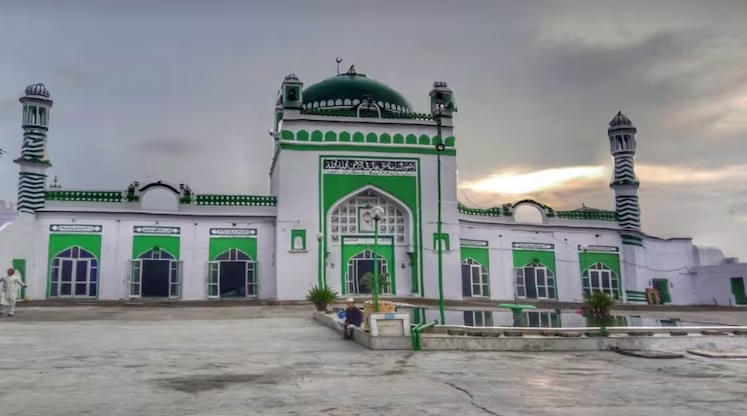Was Sambhal’s centuries-old Kalki temple destroyed?

News Mania Desk / Piyal Chatterjee / 26th November 2024
Sambhal, Uttar Pradesh, was in disarray on Sunday morning. A crowd of hundreds surrounded the Shahi Jama Masjid from three sides as a seven-person delegation ordered by the court entered to conduct a survey. Stones were thrown, cars were burned, and gunshots were fired as the situation spiraled into total mayhem. There were four fatalities. After twenty-four hours, the situation in Sambhal is far from normal. A day after the rioting, Sambhal town has banned big gatherings, suspended mobile internet, and closed schools.
Actually, a bitter disagreement about the Shahi Jama Masjid and its past is what led to the chaos that occurred in Sambhal. According to Hindus, the mosque was constructed following the destruction of the centuries-old Shri Hari Har Temple, which was devoted to Kalki, Lord Vishnu’s tenth and unborn avatar. What are the findings of an 1879 report by the Archaeological Survey of India (ASI) and historians?The second survey was ordered by the Sambhal court in response to a petition filed on November 19 alleging that the Shahi Jama Masjid was built on the foundations of an old Kalki temple.
According to the Hindu side’s spokesman, Vishnu Jain, the Mughal Emperor Babur destroyed the Shri Hari Har Temple in 1526. According to the Hindu side, the Kalki temple was being used “forcibly and unlawfully” by the Jama Masjid Committee. In response to the plea, the court designated an advocate commissioner to carry out a preliminary survey on the same day. The commotion in Sambhal occurred on Sunday during the second survey. Additionally, the team was mandated by the court to turn in a survey report by November 29.
The birthplace of Kalki, who is supposed to emerge towards the conclusion of Kaliyuga and put an end to it, is Sambhal in Western Uttar Pradesh. The new Satyayuga will begin after Kaliyuga ends. Babur may have chosen to destroy the temple in issue in Sambhal because the end of the yuga coincided with the idea of doomsday. During Babur’s rule (1526-1530), an old temple in Sambhal was destroyed, according to historians like Meenakshi Jain and Sri Ram Sharma. Historian Meenakshi Jain claims that Babur, the founder of the Mughal Empire in India, ordered the destruction of a temple in Sambhal, just as he had done in Ayodhya.
“The second mosque that he (Babur) built in India, was at Sambhal. Babar ordered his general to destroy that temple, and a mosque was built on his orders,” historian Meenakshi Jain said in an interview on a YouTube channel in 2023. “The inscription on the mosque clearly says that it was built on the orders of Babar and pieces of the temple was used in the construction of the mosque,” Jain wrote in her book, The Battle for Rama — Case of the Temple at Ayodhya.
“One of his (Babur’s) officers, Hindu Beg, is said to have converted a Hindu temple at Sambhal into a mosque. His Sadr, Shaikh Zain, demolished many Hindu temples at Chanderi (MP) when he occupied it,” historian Sri Ram Sharma wrote in his 1940 book, ‘The Religious Policy of the Mughal Emperors’.
Vishnu Jain, the advocate of the Hindu side, citing Babur’s autobiography Baburnama, has claimed that, “In 933 hijri, Babur transformed a Hindu temple into a mosque in Sambhal. It was done on Babur’s orders and is commemorated in an inscription still existing on the mosque”.
He asserted that the temple, known as the Shri Hari Har Temple, was devoted to Kalki and had connections to both Lord Shiva and Lord Vishnu. Another temple devoted to Kalki is thought to have been built at Sambhal itself in the 18th century by Ahilyabai Holkar, the Maratha ruler of Malwa, centuries after the mosque was built. The temple, known as the Kalki Mandir, was constructed just 300 metres from the Shahi Jama Masjid.He asserted that the temple, known as the Shri Hari Har Temple, was devoted to Kalki and had connections to both Lord Shiva and Lord Vishnu.
In a study released by the Archaeological Survey of India (ASI) in 1879, British archaeologist ACL Carlleyle noted that a large portion of the mosque was constructed using rubble-masonry. Often used for walls or foundations, rubble masonry is a construction method that uses unevenly shaped stones from an earlier project that are held together with mortar.
“The walls of the central square Hindu temple would appear to have been built with large bricks cased with stone, but the plaster with which the Muhammadans have coated the walls conceals the material of which they are made; and I can only say that, on examining several spots where the plaster was broken, I found that in some places stone was exposed,” he said in the report.
“I believe that the Muhammadans stripped off most of the stone, especially such as bore traces of Hinduism, and made a pavement of the stones, turning the sculptures downwards,” Carlleyle added.
Carlyle also noted the prevalence of doubts about the authenticity of the Babur inscription, which is often cited as evidence that the mosque was commissioned by him.
“Musalmans of Sambhal confessed to me that the inscription containing Babar’s name was a forgery, and that the Muhammadans did not get possession of the building until about the time of the mutiny [the revolt of 1857], or a little before it, say about 25 years ago,” Carlyle wrote in Report Of Tours In The Central Doab And Gorakhpur In 1874-75 And 1875-76.
About 20 kilometers from the contested location, in the Sambhal region of Uttar Pradesh, Prime Minister Narendra Modi lay the foundation stone for a Kalki Dham Temple earlier this year in February. Modi voiced hope during the event that Shri Kalki Dham would become yet another important hub of Indian religion. “The effects of Lord Ram’s reign were felt for thousands of years. “Kalki will have a thousand-year impact, just like Lord Ram,” Modi declared at Sambhal in February. Acharya Pramod Krishnam is the chairman of the Shri Kalki Dham Nirman Trust, which is building the Kalki Dham temple.
Krishnam was expelled from the Congress party for his anti-party remarks in February.
Now, months later, a court-mandated survey of Sambhal’s Shahi Jama Masjid, claimed to be built over a centuries-old Kalki temple during Babur’s reign, has triggered violent clashes, leaving four dead. The mosque in Sambhal is an ASI-protected site where Muslims have been praying for many centuries.






